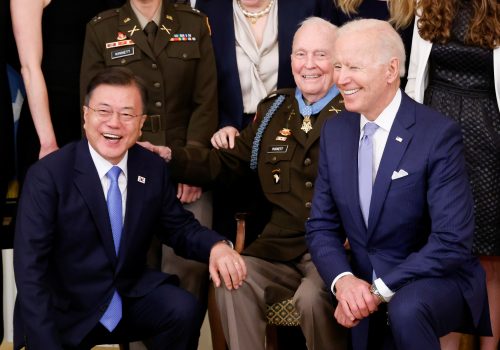FAST THINKING: Missiles are flying again on the Korean peninsula
GET UP TO SPEED
They’re airing their grievances. Tensions are high again on the Korean peninsula following a series of missile launches in recent days. On Wednesday, South Korea tested a submarine-launched ballistic missile just hours after North Korea fired two similar projectiles into the sea—and two days after it launched cruise missiles believed to be capable of carrying a nuclear warhead. So is nuclear diplomacy with the North all but dead? How worried should we be about these missiles? Our experts (who note they’re both now out of government service and sharing their own views) took aim at the big questions.
TODAY’S EXPERT REACTION COURTESY OF
- Markus Garlauskas (@Mister_G_2): Nonresident senior fellow with the Scowcroft Center for Strategy and Security and former US national intelligence officer for North Korea
- Commander (Ret.) Fredrick “Skip” Vincenzo: Visiting senior US naval special warfare fellow with Scowcroft’s Forward Defense practice and a former Korea expert with US Special Operations Command who served more than twelve years on the Korean peninsula
Off the mark
- Before this week’s launches, which coincided with US-Japanese-South Korean talks on North Korea in Tokyo, Kim Jong Un’s regime had been largely silent on the weapons front since March, when it last tested a ballistic missile. That led to speculation that the North Korean government was strapped for resources or preoccupied with domestic concerns. Not so, according to Markus, who says the latest launches are “clear signs of Pyongyang’s willingness to defy international opposition to its nuclear and missile programs, despite the economic challenges it is facing.”
- Some commentators read too much into the lack of new nuclear-capable weapons at North Korea’s recent public military parades, Markus adds. He believes Kim is motivated to make good on the “boldly stated goals for his nuclear and missile programs” that the North Korean leader outlined at a party congress in January.
- These smaller tests, moreover, provide crucial data that has helped North Korea steadily improve its nuclear and missile capabilities while avoiding uncontrolled escalation with the United States, Skip points out.
- “It’s easy to view singular launches simply as individual provocations with short-term motives, such as gaining the Biden administration’s attention,” Skip notes. “But this misses the bigger picture that, regardless of the short-term effects, North Korea is doing what it has publicly and consistently said it would do—developing the means to hold American interests at real risk.”
Within range
- The weapons North Korea just tested aren’t of the intercontinental ballistic missile variety—that is, they’re not capable of reaching US territory. Still, Markus points out, these short-range ballistic and cruise missiles (which can travel around 500 and 950 miles, respectively) can target US allies South Korea and Japan with nuclear warheads, as well as “key US military bases with tens of thousands of US military personnel and hundreds of thousands of US civilians who live and work in northeast Asia.”
- Similarly, Skip believes it’s foolhardy to assume Pyongyang doesn’t pose a clear threat just because it hasn’t tested a nuclear bomb in years, since given the current trajectory it’s increasingly likely that the Kim regime will be able to credibly target US cities with a nuclear warhead “in the not-too-distant future.”
- “At that point,” Skip notes, “Kim will have no problem holding Washington’s attention, but it’s less clear what Washington will be able to do about it.”
Don’t back down
- With diplomatic engagement with North Korea stalled since 2019, the United States and its regional allies should focus on strengthening deterrence rather than worrying about provoking Pyongyang, Markus argues. Restricting US-South Korean military exercises while North Korea flouts UN Security Council resolutions would be “unwise,” he says, as would “drawing a false equivalence between prohibited North Korean launches and legitimate, responsible South Korean conventional weapons development.” The South Koreans, he points out, have signed the nuclear Non-Proliferation Treaty.
- China also deserves its share of blame here, Markus points out. Even though China supported Security Council resolutions banning these kinds of launches, we’re only hearing crickets from Beijing after North Korea’s recent tests.
- “The world must recognize that the national-security challenges posed by China and North Korea are deeply intertwined,” Markus says, “and that North Korea only poses the threats that it does to the international order because of the support and protection China provides.”
Further reading
Sat, May 22, 2021
FAST THINKING: How do you solve a problem like North Korea?
Fast Thinking By
Our experts break down the White House meeting between US President Joe Biden and South Korean President Moon Jae-in on North Korea, space, trade, and more.
Mon, Apr 26, 2021
Reality Check #5: Learning to live with a nuclear North Korea
Reality Check By Robert A. Manning
North Korea's nuclear program is firmly established. Living with a de facto nuclear North Korea may be the least-bad option for now, requiring continued pressure and stronger deterrence measures.
Thu, Mar 25, 2021
FAST THINKING: North Korean missiles are back
Fast Thinking By
North Korea never waits long to greet a new US president with a challenge, and Biden now has his in the form of projectiles landing off the coast of Japan. What does it all mean?
Image: People watch a TV broadcasting file footage of a news report on North Korea firing what appeared to be a pair of ballistic missiles off its east coast, in Seoul, South Korea, September 15, 2021. REUTERS/Kim Hong-Ji


